Women’s Football History Exhibition: 150 Years of Courage and Conviction - Featuring The Lizzy Ashcroft Collection
05/12/2023 - 11.10
Steve Bolton
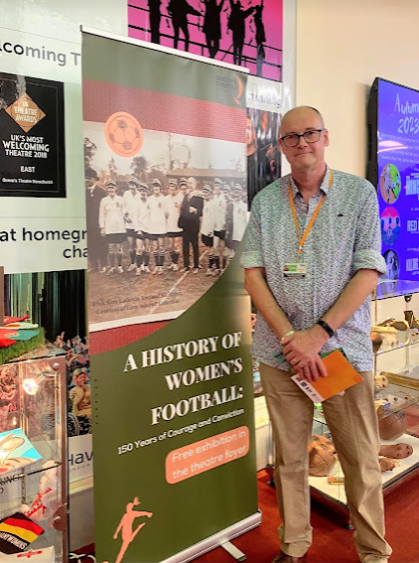
“A History of Women’s Football”
Exhibition Banner with Curator - September 2023
Queen’s Theatre Foyer - Hornchurch, Havering, NE London
(Source: Author’s Collection)
Historical Consultant and Exhibition Curator
During the Summer of 2023 the Queen’s Theatre in Hornchurch engaged me as the Historical Consultant for their new play: “The Invincibles”. I was also engaged to curate and present a free exhibition about the history of women’s football featuring items from the Lizzy Ashcroft Collection. The Play and the Exhibition were very successful and complemented each other. This is an attempt to preserve and share the exhibition more widely. Everyone at the Queen’s Theatre was so helpful and positive. Please note that thanks and acknowledgements follow at the end of this article.
The Invincibles Play and Exhibition
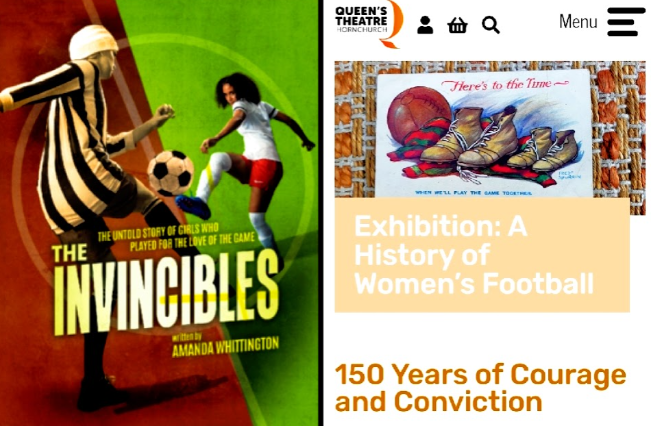
Queen’s Theatre Advertising for Play and Exhibition
(Courtesy: The Queen’s Theatre)
“Culturally Significant Artefacts”
“Rare and distinctive items dating from the turn of the century to present day are on display, including items from the women’s football legend Lizzy Ashcroft Collection and her grandson Steve’s personal collection which is packed with culturally significant artefacts. You will have the chance to touch and smell the leather of vintage football boots and balls, take a peek inside match day programmes from across the decades and enjoy reading from our loaned library of women’s football books in the café. In spite of repeated English FA bans on women’s football, the game has flourished through the decades. This exhibition highlights the skill and determination of women like Carmen Pomies, Lizzy Ashcroft and Lily Parr, who blazed a trail for women’s football playing for the famous Dick Kerr Ladies, celebrating their achievements and those of our Lionesses today.”
“Known as the Dagenham Invincibles, Sterling Ladies are the greatest women’s football team of World War One. Over two whirlwind seasons they will never lose a game. Yet in 1919, the factory girls hang up their boots and triumphs fade into obscurity…In 2023 their war-cry is heard in the roar of the Lionesses. The world has changed, yet the Women’s World Cup evokes The Invincibles joyous spirit. For Hornchurch teenager Maya, it’s the event of the summer.”
Sterling Ladies FC of WW1
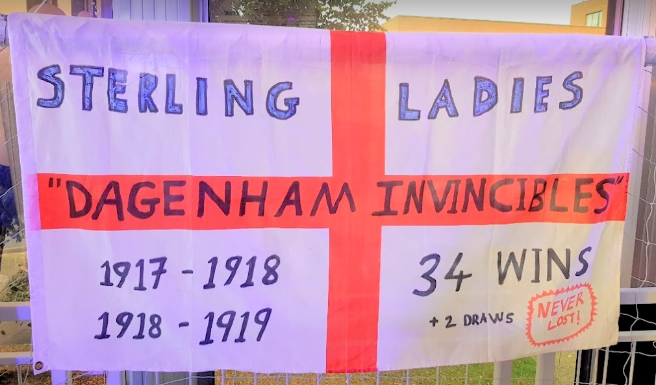
Sterling Ladies FC - 36 Games - 34 Wins and 2 Draws
(Source: Lizzy Ashcroft Collection)
World War 1 - Over 1,000 Women’s Football Matches
It is with some irony that it took the horrors of a World War to liberate the genie of women’s football out of its constrictive lamp. By the end of the 1918-1919 ‘war season’ over 250 women’s teams had played over 1,000 charity matches. It should be remembered that women moved into heavy industry to support the war effort as never before in jobs such as making shells for the front. These ‘munitionettes’ would then train and play football matches to raise money after working twelve hour shifts.
It is in no small part that we owe our freedom today to those brave women.
The ‘Essex scene’ and indeed the truly great Sterling Ladies FC have been completely overlooked and forgotten until now. Their unique record stands at 36 matches played, 34 won and only 2 draws over two full seasons, scoring 201 goals and conceding a miserly 14. During their first season, superstar centre forward Maud Smith scored 38 goals out of 103 scored by the team. They were THE ‘poster girls’ of women’s football, in their iconic blue, quartered kit. They were seen in cinemas up and down the country featuring regularly in the Pathe news clips of the time, which can still be seen today. Their picture featured in regional newspapers as well as the national Daily Mirror, the Illustrated Sporting and Dramatic News and even ‘The Tatler’. Their picture also featured in the papers as far away as the New York Herald, the Ottawa Citizen and the Honolulu Star.
Queen’s Theatre Exhibition - “Selfie Heaven”
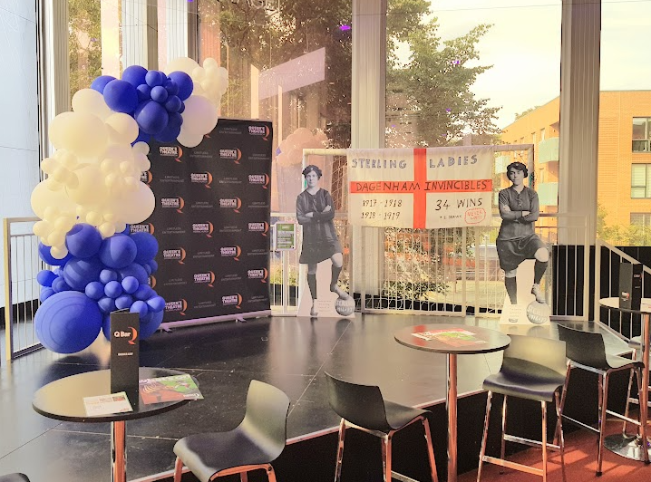
“Selfie Heaven” - The Other Stage, Queen’s Theatre Foyer
Gladys and Ada Fairman Courtesy Valence House
(Source: Lizzy Ashcroft Collection)
Gladys and Ada Fairman - Dagenham Invincibles
Gladys and Ada Fairman were key members of the Sterling Ladies and form two of the central characters of the Play. Valence House Museum, Dagenham were exceptionally generous in giving us access and permission to use some of the amazing images from their archive. The Sterling Ladies FC wore one of the most iconic kits in women's football history with their blue quartered tops. However, in the very early 1916-1917 season they played inter-department football matches of which I have been able to find records of three games, Assembly Room v Machine Room. Ada Fairman played for the Assembly room in black and red stripes and original superstar forward Maud Smith played for the Machine room in blue and white stripes. This was an extremely popular part of the exhibition.
Queen’s Theatre Exhibition - “Library Corner”
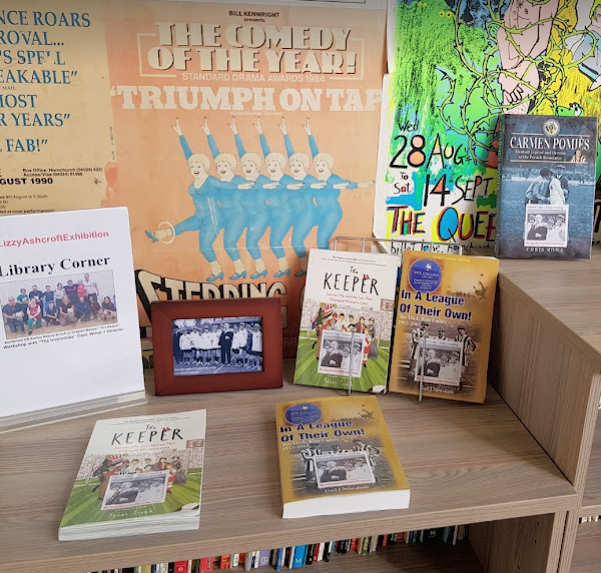
Library Corner, Queen’s Theatre
Signed Copies ‘Carmen Pomies’, ‘The Keeper’, ‘In A League of Their Own’
(Source: Lizzy Ashcroft Collection)
The Queen’s Theatre - A Thriving Community Hub
The Queen’s Theatre has a huge, welcoming foyer which wraps around the entire building. Events take place all week from early in the morning to shows at night. The foyer is a very busy area with a huge variety of events. The foyer has a bar at one end and a cafe at the other end with a large seating area. At the end of the seating area is a small library with comfortable seating. I was able to lend some special, signed copies of books from the Lizzy Ashcroft Collection. Chris Rowe, author of ‘Carmen Pomies’ and Kelcey Ervick author of ‘The Keeper’ generously donated copies for the Exhibition itself.
Queen's Theatre Exhibition - “Postbox Topper”
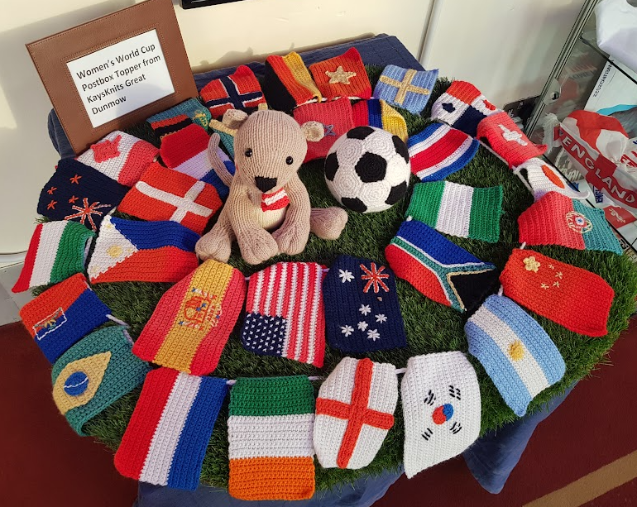
1923 Women’s World Cup in Australia - Postbox Topper
Courtesy - KaysKnits Great Dunmow
(Source: Lizzy Ashcroft Collection)

“The Keeper” Author Kelcey Ervick and sister Darcy
(Source: Lizzy Ashcroft Collection)
KaysKnits
Sincere thank you to Kathleen, Jackie and Charlotte at KaysKnits for re-configuring this stunning community art especially for the exhibition. Kelcey and Darcy visited to see it at my local Tesco’s, all the way from the USA. This was a very popular part of the exhibition.
Queen’s Theatre Exhibition - “Feedback Station”

Feedback Station and Feedback Postcard
(Source: Lizzy Ashcroft Collection)
“Girls Ought Not To Play Football!”
We had some amazing feedback about both the play and the exhibition. Highlights were 80-year old Ray who had travelled all the way from Crewe on the train and mother and daughter from Bath who had also made a long journey. The feedback about both the play and the exhibition was almost uniformly positive with comments such as:
“Glad now that women have changed the perception of the game!”
“Very interesting display. I hadn't realised the restrictions against women. Fascinating memorabilia. Wonderful photos. Well done.”
“Deserves a sell-out every Show! I didn't know this amazing piece of history. Thank you so much.”
It was really interesting to note that the younger girls who posted feedback did not appreciate the irony of the 1917 Postcard and just wrote quite angrily that girls can play football…
Queen’s Theatre Exhibition - “Sensory Experience”
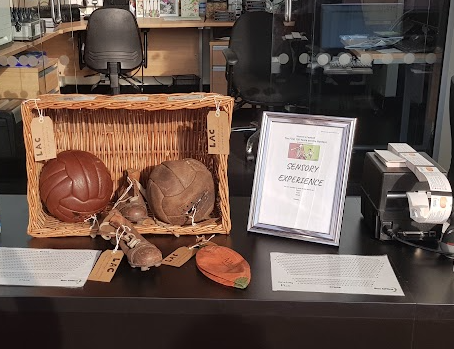
Sensory Experience on Booking Desk
(Source: Lizzy Ashcroft Collection)
Vintage Leather Footballs and Boots
This was a very popular part of the exhibition. Boot and ball technology did not really change significantly from the end of the Victorian era to post World War 2. The Adidas Argentina with its revolutionary screw-in stud (and lack of steel toe cap!) was not introduced until 1954. It was really good fun chatting to people and encouraging them to feel and smell the objects. The bladder and nail in leather studs caused the most interest and although I expected younger people not to know what they were I was surprised at the number of adults who weren’t sure. The Front of House Staff at Queen’s Theatre got really involved and as well as keeping an eye on the display were extremely enthusiastic in helping to promote the display.
Queen’s Theatre Exhibition Display Cabinet - “The Lionesses”
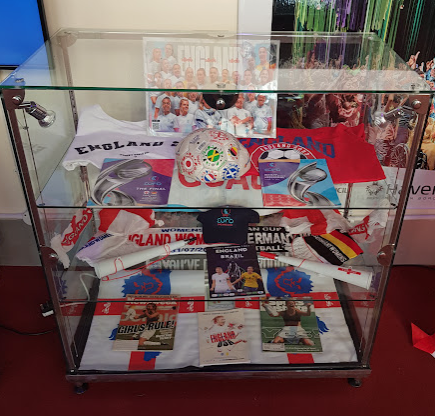
“The Lionesses” Display Cabinet
(Source: Lizzy Ashcroft Collection)
Women’s Football - The Modern Fan Experience
This cabinet was a celebration of the Lionesses and their success. I included some free merchandising and some of my memorabilia from the Euros Final including a scarf and match programme. I suspect that a lot of English people think that Chloe Kelly thought up her famous goal celebration, and don’t realise she was paying homage to Brandi Chastain. I included my original copies of ‘Newsweek’ and ‘Sports Illustrated’ from the 1999 World Cup Final in Pasadena where Brandi Chastain did her famous sports bra celebration after scoring the winning penalty in the World Cup Final.
Queen’s Theatre Exhibition Display Cabinet - “Vintage Items”
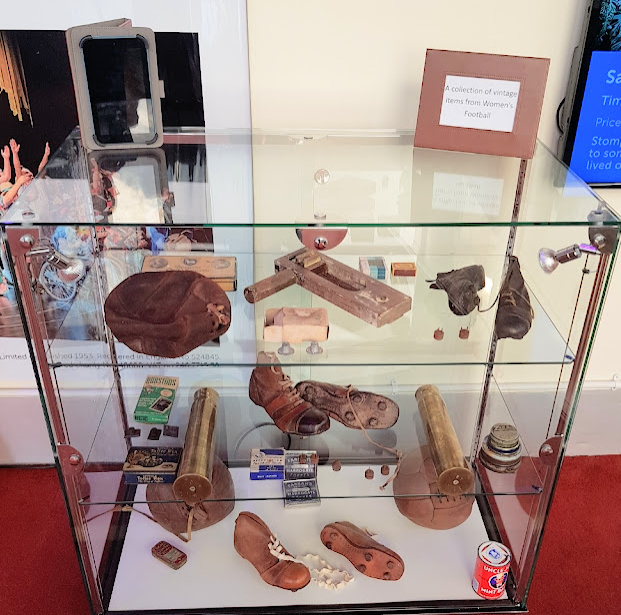
“Vintage Items” Display Cabinet
(Source: Lizzy Ashcroft Collection)
Women’s Football - Vintage Items
This cabinet was a chance to demonstrate some of the more valuable vintage items from the Lizzy Ashcroft Collection. It became clear talking to people that a lot of people did not recognise the beautifully etched shells from World War 1 and their significance. I had to design the entire exhibition at home without having seen any of the cabinets and this one would have benefited from some labels, or an exhibition guide. Logistics did not allow for this at the time. Unfortunately, the trench art (shells) were too valuable to put in the Sensory Experience part of the exhibition. I was, however, able to open the cabinet and demonstrate to a number of visitors. The football on the bottom right has the most pronounced stitching and it was generally agreed that one’s forehead would suffer badly if sliding contact was made.
Queen’s Theatre Exhibition Display Cabinet - “100 Years of Match Programmes”
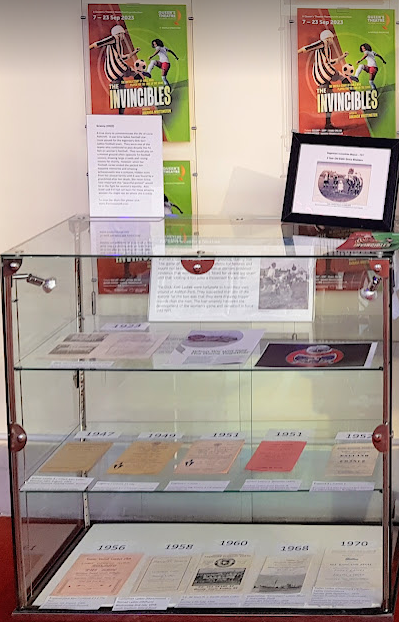
“100 Years of Match Programmes” Display Cabinet
(Source: Lizzy Ashcroft Collection)
Women’s Football - 100 Years of Match Programmes
The Lizzy Ashcroft Collection has women’s football programmes stretching over 102 years. My earliest programme is a 1921-1922 ‘ban season’ Dick Kerr Ladies vs Coventry programme from a game at St Andrews, Birmingham. This was one of the last games allowed on an English FA affiliated football pitch for over 49 years. I have programmes from every decade up to and including the Euros final in 2022. This is unique in any private or public collection. My prize possession is the 1923 Dick Kerr Ladies v Stoke programme. My granny, Lizzy Ashcroft made her debut in 1921 at St Andrews at the age of 16 in front of a crowd of 30,000 for the great St Helens against Stoke. St Helens played Stoke 4 times, which included 3 draws and one win. In 1923 St Helens thrashed the Dick Kerr Ladies 5 v 1 (Lily Parr playing for DKL) and my granny, together with Susie Chorley and Lydia Ackers became Dick Kerr Ladies. Lizzy’s 7th game for her new side, the famous Dick Kerr Ladies was played against Stoke. It was the midland’s side's last ever game and they defeated the DKL by 1 v 0. It is very, very special for me to have a programme with my granny’s name which is 100 Years old. The fact that it was a gift from my friend Kathryn Hey, of Hey’s Brewery FC Ladies is even more special.
Queen’s Theatre Exhibition Display Cabinet - “Carmen Pomies and 65 Internationals”
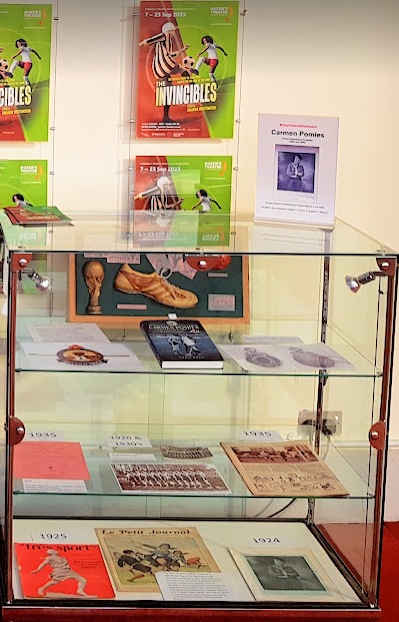
“Carmen Pomies and 65 Internationals” Display Cabinet
(Source: Lizzy Ashcroft Collection)
Legendary Footballer and Resistance Heroine Carmen Pomies
This cabinet was a tribute to my granny’s old friend, Carmen Chantelle Marianne Pomies. I have no hesitation in declaring Carmen Pomies as ‘the most important woman footballer’ in history. The cabinet contained some of my rare French magazines from the 1920s golden era of women’s football in France. There was also an original copy of Le Miroir des Sport from 1935, when my Granny captained the Dick Kerr Ladies against France at the Stade de Paris against the other legendary French footballer Madeleine ‘Mado’ Bracquemond.
This cabinet was partly stimulated by BBC Sport who on the morning of the Women’s World Cup final had Alex Scott (whom I greatly admire) read out that after the 1921 ban ‘women’s football was played on parks and in private’. I have stopped throwing things at the television, but this is just silly. Carmen brokered over 65 games in the 1930s designated as England v France or England v Belgium. The English FA ban applied to affiliated football stadia. There were, of course, unaffiliated stadia such as Fallowfield and Belle Vue in Manchester. There were also huge stadia up and down the country used by rugby league, rugby union, speedway, cricket stadia, velodromes and so on. And yes, on Monday 1st August 1932, my Granny did play on a park, Moor Park in Preston, against ‘France’. The crowd was estimated at over 10,000.
Queen’s Theatre Exhibition - “Play Up The Blues”

Mannequin in Sterling Ladies FC Iconic Kit
(Source: Lizzy Ashcroft Collection)
Poster Girls of WW1 Women’s Football
The Sterling Ladies FC were instantly recognisable in their blue quartered kit in World War 1. It is easy to forget when we watch old clips in black and white that their games would have been a riot of colour, playing against Marconi ‘The Reds’ and London General Omnibus, Forest Gate ‘The Greens’. If you went to the cinema in 1918 and a short clip of the patriotic women’s football was shown as part of Pathe News then it would generally be the Sterlings that you would be watching.
A Few Exhibition Highlights
Author Kelcey Ervick Visits from USA
Author Kelcey Ervick gives a Q and A to Writer Amanda Whittington, Director Mathew Grieve, Assistant Director Rebecca Goh and Cast. Signed copies of ‘The Keeper’ graphic book were made available.

(Source: Lizzy Ashcroft Collection)
All the way from Crewe
80-year old Ray journeyed all the way from Crewe. He had read Alyson Rudd’s fantastic Times Article about the Play. He was originally from Hornchurch and so felt he had to see the Exhibition and Play.
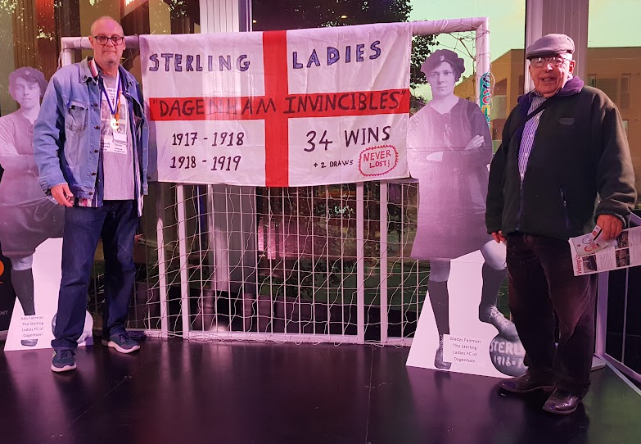
(Source: Lizzy Ashcroft Collection)
Mascot Identification Confirmed
Sterling Ladies FC 2-year old mascot Edith Grace Shalders. Mathew Smith from Durham contacted me shortly before the exhibition with this photo from his late mother’s collection. Edie was a school friend of his Aunt Bessie Prior. At one time Malcolm’s mother and grandparents lived in Hornchurch.
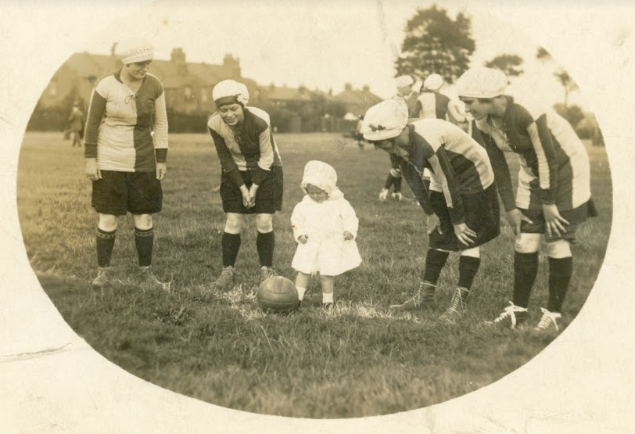
(Courtesy of Mathew and Justin Smith)
An Emotional Visit from Bath
Mother and Daughter “What a Play and what a fascinating Exhibition. Worth coming all the way from Bath.”

(Source: Lizzy Ashcroft Collection)
“The Invincibles” Exhibition
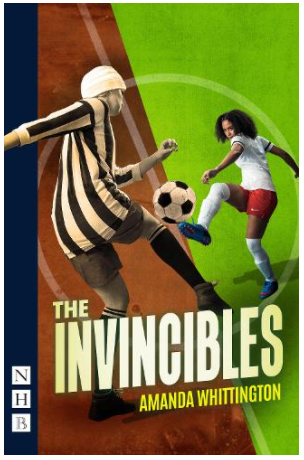
“The Invincibles” by Amanda Whittington
NHB Modern Plays Paperback of Script
(Source: Author’s Collection)
The Dagenham Invincibles
I owe my role as Historical Consultant and Exhibition Curator thanks to two amazing women: my granny Lizzy Ashcroft and playwright Amanda Whittington. Rooting around in an old family loft several years ago, I found three suitcases stuffed with my granny’s unique football memorabilia, including her beautiful debut medal. She was only 16 years old in 1921 when she made her debut in front of 30,000 at St Andrews, home of Birmingham FC. This ignited my passion for women’s football.
Amanda contacted me over a year ago and asked if I could recommend a historical team local to the Queen’s Theatre for a play. Wow - The Sterlings! World War 1 was a time of immense and complex social change and thus began a huge amount of research, with many, many discussions. Director James Grieve generously invited me to spend a couple of days with the cast and share my knowledge and thoughts, as the actors strove to immerse themselves in the era and inhabit their characters. I cannot begin to articulate how exciting it has been to be involved in this special project.
I must also especially thank Queen’s Theatre Chief Executive Mathew Russell who enthusiastically commissioned the exhibition to accompany the play. Francesca Clark worked very closely with me on an extremely tight deadline to Project Manage the logistics with great support from Queen’s Theatre Creative Director Kate Lovell. My thanks to all at the Theatre and the Play.
I am going to sign off with the words of Molly, aged 9:
“Girls should always be able to play football”
Biography
Steve Bolton was awarded a BSc (Hons) in Mathematics from University College London) and a Post Graduate Certificate in Education from the University of Nottingham. Steve’s passion is researching and writing about the history of women’s football. I have had several articles published and he is currently working on his first book: “Granny Played Football”. Granny Lizzy Ashcroft was one of the most influential and important pre-WW2 women’s footballers. She made her debut at the age of 16 for St Helens Ladies at St Andrews in April 1921 in front of a crowd of 30,000. After the English FA ban she joined the Dick Kerr Ladies in 1923 where she played until her retirement in 1935. She was Vice-Captain under Lily Parr from 1932-1934 and in 1935 took over the captaincy from her great mate Lily and led the DKL only their second ever continental tour. Steve is custodian of the Lizzy Ashcroft Collection which is one of the foremost collections of pre-World War Two women’s football memorabilia in private hands.
Steve’s Twitter handle is: @DagenhamInvince and he can be contacted by email at: lizzyashcroftfootballer@gmail.com



/prod01/wlvacuk/media/departments/digital-content-and-communications/images-2024/240328-Varsity-Line-Up-Resized.jpg)
/prod01/wlvacuk/media/departments/digital-content-and-communications/images-18-19/220325-Engineers_teach_thumbail.jpg)
/prod01/wlvacuk/media/departments/digital-content-and-communications/images-2024/240515-Spencer-Jones-Award-Resized.jpg)
/prod01/wlvacuk/media/departments/digital-content-and-communications/images-2024/240320-Uzbekistan-Resized.jpg)
/prod01/wlvacuk/media/departments/digital-content-and-communications/images-2024/240229-The-Link-Resized.jpg)
/prod01/wlvacuk/media/departments/digital-content-and-communications/images-2024/240516-Andy-Gibson-Resized.jpg)